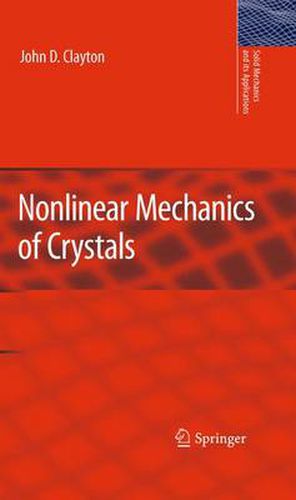Readings Newsletter
Become a Readings Member to make your shopping experience even easier.
Sign in or sign up for free!
You’re not far away from qualifying for FREE standard shipping within Australia
You’ve qualified for FREE standard shipping within Australia
The cart is loading…






This title is printed to order. This book may have been self-published. If so, we cannot guarantee the quality of the content. In the main most books will have gone through the editing process however some may not. We therefore suggest that you be aware of this before ordering this book. If in doubt check either the author or publisher’s details as we are unable to accept any returns unless they are faulty. Please contact us if you have any questions.
This book describes behavior of crystalline solids primarily via methods of modern continuum mechanics. Emphasis is given to geometrically nonlinear descriptions, i.e., finite deformations.
Primary topics include anisotropic crystal elasticity, plasticity, and methods for representing effects of defects in the solid on the material’s mechanical response. Defects include crystal dislocations, point defects, twins, voids or pores, and micro-cracks. Thermoelastic, dielectric, and piezoelectric behaviors are addressed. Traditional and higher-order gradient theories of mechanical behavior of crystalline solids are discussed. Differential-geometric representations of kinematics of finite deformations and lattice defect distributions are presented. Multi-scale modeling concepts are described in the context of elastic and plastic material behavior. Representative substances towards which modeling techniques may be applied are single- and poly- crystalline metals and alloys, ceramics, and minerals.
This book is intended for use by scientists and engineers involved in advanced constitutive modeling of nonlinear mechanical behavior of solid crystalline materials. Knowledge of fundamentals of continuum mechanics and tensor calculus is a prerequisite for accessing much of the text. This book could be used as supplemental material for graduate courses on continuum mechanics, elasticity, plasticity, micromechanics, or dislocation mechanics, for students in various disciplines of engineering, materials science, applied mathematics, and condensed matter physics.
$9.00 standard shipping within Australia
FREE standard shipping within Australia for orders over $100.00
Express & International shipping calculated at checkout
This title is printed to order. This book may have been self-published. If so, we cannot guarantee the quality of the content. In the main most books will have gone through the editing process however some may not. We therefore suggest that you be aware of this before ordering this book. If in doubt check either the author or publisher’s details as we are unable to accept any returns unless they are faulty. Please contact us if you have any questions.
This book describes behavior of crystalline solids primarily via methods of modern continuum mechanics. Emphasis is given to geometrically nonlinear descriptions, i.e., finite deformations.
Primary topics include anisotropic crystal elasticity, plasticity, and methods for representing effects of defects in the solid on the material’s mechanical response. Defects include crystal dislocations, point defects, twins, voids or pores, and micro-cracks. Thermoelastic, dielectric, and piezoelectric behaviors are addressed. Traditional and higher-order gradient theories of mechanical behavior of crystalline solids are discussed. Differential-geometric representations of kinematics of finite deformations and lattice defect distributions are presented. Multi-scale modeling concepts are described in the context of elastic and plastic material behavior. Representative substances towards which modeling techniques may be applied are single- and poly- crystalline metals and alloys, ceramics, and minerals.
This book is intended for use by scientists and engineers involved in advanced constitutive modeling of nonlinear mechanical behavior of solid crystalline materials. Knowledge of fundamentals of continuum mechanics and tensor calculus is a prerequisite for accessing much of the text. This book could be used as supplemental material for graduate courses on continuum mechanics, elasticity, plasticity, micromechanics, or dislocation mechanics, for students in various disciplines of engineering, materials science, applied mathematics, and condensed matter physics.